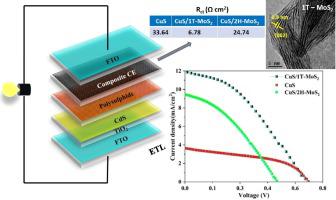当前位置:
X-MOL 学术
›
Mater. Res. Bull.
›
论文详情
Our official English website, www.x-mol.net, welcomes your feedback! (Note: you will need to create a separate account there.)
Performance of Functionalized 1T-MoS2 as Composite Counter Electrode Material for QDSSCs and its Analogy with 2H-MoS2
Materials Research Bulletin ( IF 5.4 ) Pub Date : 2021-02-01 , DOI: 10.1016/j.materresbull.2020.111096 Bhakti Kulkarni , Mabkhoot Alsaiari , Jyothi M S , Kusuma J , Mohammed Jalalah , Farid A. Harraz , R. Geetha Balakrishna
Materials Research Bulletin ( IF 5.4 ) Pub Date : 2021-02-01 , DOI: 10.1016/j.materresbull.2020.111096 Bhakti Kulkarni , Mabkhoot Alsaiari , Jyothi M S , Kusuma J , Mohammed Jalalah , Farid A. Harraz , R. Geetha Balakrishna

|
Abstract 1 T phase of MoS2 has been recently established as a high photo and electro active catalyst for hydrogen generation and energy storage applications. The present study explores the possibility of utilizing its enhanced features for photovoltaic applications with a detailed analogy of the two phases of MoS2 for counter electrode applications in Quantum dot sensitizes solar cells (QDSSCs). The two phases namely 2H and 1 T phase of MoS2 have been synthesized by two different approaches namely bottom up and top down methods. The functionalized (stabilized) 1 T phase shows a significant improvement in its photovoltaic performance over 2H phase as a composite counter electrode (CE) material used with CuS in QDSSCs. The study is supported by material characterization via microscopy, spectroscopy and electrochemical characterization through impedance studies. The metallic 1 T phase with its bandgap less than 1 eV significantly improves the electron life time, charge transfer, charge separation and hence the overall performance of the QDSSCs thus offering itself as a new stable photovoltaic CE material.
中文翻译:

功能化 1T-MoS2 作为 QDSSCs 复合对电极材料的性能及其与 2H-MoS2 的类比
摘要 MoS2 的 1 T 相最近被确立为一种用于氢生成和储能应用的高光和电活性催化剂。本研究探讨了将其增强功能用于光伏应用的可能性,并详细模拟了二硫化钼的两相,用于量子点敏化太阳能电池 (QDSSC) 中的对电极应用。MoS2 的 2H 相和 1T 相这两个相已通过两种不同的方法合成,即自底向上和自顶向下方法。功能化(稳定化)的 1 T 相作为复合对电极 (CE) 材料与 QDSSC 中的 CuS 一起使用,其光伏性能比 2H 相显着提高。该研究得到了通过显微镜进行的材料表征的支持,通过阻抗研究进行光谱和电化学表征。带隙小于 1 eV 的金属 1 T 相显着提高了电子寿命、电荷转移、电荷分离,从而提高了 QDSSC 的整体性能,从而使其成为一种新型稳定的光伏 CE 材料。
更新日期:2021-02-01
中文翻译:

功能化 1T-MoS2 作为 QDSSCs 复合对电极材料的性能及其与 2H-MoS2 的类比
摘要 MoS2 的 1 T 相最近被确立为一种用于氢生成和储能应用的高光和电活性催化剂。本研究探讨了将其增强功能用于光伏应用的可能性,并详细模拟了二硫化钼的两相,用于量子点敏化太阳能电池 (QDSSC) 中的对电极应用。MoS2 的 2H 相和 1T 相这两个相已通过两种不同的方法合成,即自底向上和自顶向下方法。功能化(稳定化)的 1 T 相作为复合对电极 (CE) 材料与 QDSSC 中的 CuS 一起使用,其光伏性能比 2H 相显着提高。该研究得到了通过显微镜进行的材料表征的支持,通过阻抗研究进行光谱和电化学表征。带隙小于 1 eV 的金属 1 T 相显着提高了电子寿命、电荷转移、电荷分离,从而提高了 QDSSC 的整体性能,从而使其成为一种新型稳定的光伏 CE 材料。


























 京公网安备 11010802027423号
京公网安备 11010802027423号